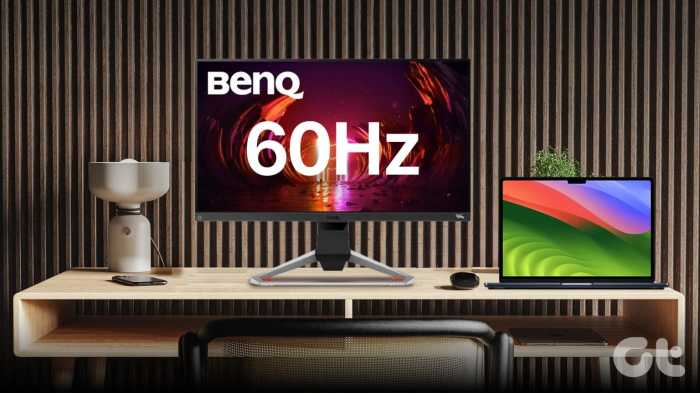Why does high refresh rate display use more battery? This question delves into the fascinating relationship between screen technology and power consumption. We’ll explore how the display’s refresh rate impacts battery life, examining the underlying mechanisms and external factors at play. From the basics of how a high refresh rate display works to the future of display technology, we’ll unpack everything to give you a comprehensive understanding.
High refresh rates, like 120Hz or 144Hz, offer smoother visuals, but they come at a cost. The increased rate of image updates requires more power. We’ll look at how the backlight, pixel control, and image rendering contribute to this higher energy demand. Different display technologies like LCD and OLED also affect energy consumption at various refresh rates. Understanding these factors is key to making informed choices about your next display.
Display Refresh Rate and Power Consumption
High refresh rate displays are becoming increasingly popular, offering smoother visuals and a more responsive experience. However, this enhanced performance often comes at a cost: higher power consumption. Understanding the mechanics behind this relationship is crucial for making informed choices about your next display. This section dives deep into the intricacies of display refresh rates and their impact on battery life.
How a High Refresh Rate Display Works
A high refresh rate display, unlike a standard 60Hz display, refreshes the image on the screen many times per second. This rapid refresh creates the illusion of smoother motion and reduces the “stuttering” or “tearing” effect that can occur at lower refresh rates. The display controller sends signals to the backlight and the pixels to update the image in a synchronized manner.
This process is repeated at a specific frequency, measured in Hertz (Hz). For example, a 144Hz display refreshes the image 144 times per second.
Relationship Between Refresh Rate and Power Consumption
The relationship between refresh rate and power consumption is directly proportional. Higher refresh rates require more frequent updates to the screen, which necessitates more power to drive the components responsible for these updates. This increased demand for power is not negligible and can significantly impact battery life, especially on mobile devices.
Power Consumption Comparison Across Refresh Rates
Different refresh rates consume varying amounts of power. A 60Hz display, the standard refresh rate for many devices, will generally use less power than a 144Hz or 240Hz display. The difference in power consumption becomes more pronounced as the refresh rate increases. For example, a 120Hz display will consume more power than a 60Hz display, and a 240Hz display will consume even more.
This difference is due to the increased workload placed on the display’s components to maintain the higher frame rate.
Components Contributing to Power Consumption
Several components within a display contribute to power consumption, with the refresh rate playing a crucial role. The backlight, which illuminates the pixels, is a significant consumer of power. The higher the refresh rate, the more frequently the backlight needs to be activated and dimmed, increasing power consumption. The panel itself, including the transistors and circuits responsible for pixel manipulation, also contribute to the overall power demand.
High refresh rate displays drain more battery because they constantly redraw the screen, requiring more power. It’s a bit like constantly redrawing a picture, which uses more paint! Luckily, if you’re a Pokémon Sword and Shield player, you can get three free mythical Pokémon soon! pokemon sword and shield players can get three free mythical pokemon soon.
This constant refresh rate, though, means more power is needed to keep up with the display, hence the battery drain.
The power required for the display controller and signal processing to maintain the high refresh rate adds to the overall power consumption.
Power Consumption Comparison Across Display Types
| Display Type | 60Hz | 120Hz | 144Hz | 240Hz |
|---|---|---|---|---|
| LCD | Low | Medium | High | Very High |
| OLED | Low | Medium | Medium-High | High |
The table above illustrates a general comparison of power consumption for different refresh rates across LCD and OLED displays. LCDs, in general, tend to consume more power at higher refresh rates than OLEDs, although OLEDs still experience an increase in power consumption as the refresh rate escalates. Note that these values are approximate and can vary based on specific display models and manufacturing processes.
Underlying Mechanisms

High refresh rate displays, while offering smoother visuals, often come with a higher energy consumption. Understanding the underlying mechanisms behind this relationship is crucial for optimizing power efficiency and developing more sustainable display technologies. Different components of the display contribute to the power consumption at varying refresh rates, impacting the overall energy usage.The power consumption difference between high and low refresh rates stems from the increased frequency of operations required to maintain the higher frame rates.
High refresh rate displays, while awesome for gaming, do consume more battery. Think of it like needing more power to refresh the screen faster. This increased demand for power is a direct result of the display’s need to update images more frequently. And while you’re thinking about power consumption, you might also want to check out shorten your weekend chores list with 300 off this T10 Omni robot vacuummop – it’ll free up some of your time for activities that don’t involve draining your battery as much, like gaming on a high refresh rate display, though! Ultimately, more frequent screen updates equate to higher power usage.
This increased frequency directly impacts the energy demands of the display’s components, particularly the backlight and pixel control mechanisms. The energy required for image rendering and display updates also scales with the refresh rate. By analyzing these individual contributions, we can identify areas where efficiency improvements are most critical.
Backlight and Pixel Control
The backlight, responsible for illuminating the display, consumes significant energy. At higher refresh rates, the backlight needs to cycle on and off more frequently to maintain the desired brightness and contrast. This increased cycling rate directly leads to higher power consumption. Similarly, pixel control circuits, which manage the color and intensity of each pixel, also operate more often at higher refresh rates, further contributing to the overall power draw.
The frequency of these operations is directly proportional to the refresh rate, and thus, higher refresh rates necessitate more frequent and powerful pixel control signals.
High refresh rate displays drain more battery because they’re constantly redrawing the screen, much like a busy artist meticulously painting a picture. This constant refresh cycle requires more power, a bit like how a fast-spinning motor uses more energy. Meanwhile, on Friday we’ll hear whether Google can delay cracking open Android on friday well hear whether google can delay cracking open android , potentially impacting future smartphone battery life in interesting ways, although the direct link to high refresh rates is likely indirect.
So, next time you’re choosing a phone, remember that faster refresh rates come at a cost, literally. It’s a trade-off between visual smoothness and battery longevity.
Image Rendering and Display Updates
Image rendering at high refresh rates demands more processing power to generate the additional frames needed for smooth motion. More frames require more computational resources and energy. This increased computational load impacts the overall power consumption. Furthermore, the display needs to update the pixels more frequently to display these new frames. This update process involves transferring data and controlling the pixels, both of which consume energy.
The processing load and data transfer involved in updating the display’s pixels increase with the refresh rate, directly influencing the power consumption.
Refresh Rate Impact on Power Efficiency
The relationship between refresh rate and power efficiency is inversely proportional. Higher refresh rates typically lead to lower power efficiency, as the increased display activity consumes more energy. This is a fundamental trade-off in display technology: higher visual quality (high refresh rates) often comes at the cost of increased power consumption. However, advanced technologies are actively being developed to mitigate this issue.
Improving Display Power Efficiency at High Refresh Rates
Several technologies are being implemented to improve the power efficiency of high refresh rate displays:
- Adaptive Brightness Control: This technology dynamically adjusts the backlight brightness based on the content being displayed. Darker scenes require less backlight intensity, reducing power consumption without compromising visual quality. This is crucial for maintaining a high refresh rate while reducing the energy usage.
- Local Dimming: By dimming or turning off specific areas of the backlight, local dimming reduces overall energy consumption, particularly in scenes with large areas of uniform color, such as a solid-colored background. This technology is effective in optimizing power usage at high refresh rates.
- Improved Pixel Drivers: Efficient pixel drivers that require less power to control the pixels are vital in maintaining high refresh rates without significantly increasing power consumption. These advanced drivers are designed to minimize energy waste during pixel switching and updating, resulting in more energy-efficient operation.
These technologies, along with other innovative approaches, aim to reduce the power consumption associated with high refresh rates, bringing us closer to displays that offer exceptional visual quality while minimizing their environmental impact.
External Factors
High refresh rate displays are becoming increasingly popular, but their power consumption isn’t solely determined by the refresh rate itself. A multitude of external factors, such as screen brightness, adaptive refresh rate technology, resolution, and HDR support, play significant roles in shaping the overall power draw. Understanding these factors is crucial for making informed decisions about display choices and maximizing battery life.
Impact of Screen Brightness
Screen brightness is a primary determinant of power consumption, regardless of the refresh rate. Higher brightness levels demand more power to illuminate the pixels. This effect is amplified at higher refresh rates because the display needs to update the pixels more frequently, requiring a greater overall energy expenditure. For example, a 120Hz display set to maximum brightness will consume more power than the same display at 60Hz and a lower brightness setting.
This relationship is directly proportional; increased brightness correlates with increased power consumption.
Influence of Adaptive Refresh Rate Technologies
Adaptive refresh rate technologies, such as variable refresh rate (VRR) and FreeSync, dynamically adjust the refresh rate based on the content being displayed. When the content is static or smooth, the refresh rate drops, reducing power consumption. Conversely, when the content has rapid motion, the refresh rate increases to maintain a smooth visual experience. This dynamic adjustment results in significant power savings compared to fixed refresh rates, particularly in scenarios with content that doesn’t require high frame rates.
The implementation of adaptive refresh rate technologies leads to optimized power usage, as the display consumes energy only when needed.
Effect of Screen Resolution
Screen resolution directly impacts power consumption. Higher resolutions necessitate more pixels to be illuminated, demanding more power to drive the display. The relationship between resolution and power consumption is generally linear, meaning that doubling the resolution roughly doubles the power needed, assuming similar brightness and refresh rate settings. For example, a 4K display will use more power than a 1080p display under identical conditions, due to the higher number of pixels needing to be refreshed.
This factor should be considered when selecting a display for mobile devices or portable systems.
Influence of HDR Support
High Dynamic Range (HDR) displays offer a wider range of colors and brightness levels, resulting in more vibrant and realistic images. HDR displays often use more power to achieve this enhanced visual experience, compared to standard displays. The difference in power consumption between HDR and non-HDR displays varies depending on the specific implementation and the brightness level, but it’s a factor to consider, particularly for applications requiring high brightness and color fidelity.
For example, HDR gaming or HDR video playback will likely consume more power than standard content.
Table of External Factors Affecting Power Consumption
| External Factor | Relation to Refresh Rate | Impact on Power Consumption |
|---|---|---|
| Screen Brightness | Directly proportional | Higher brightness leads to increased power consumption at all refresh rates. |
| Adaptive Refresh Rate (VRR) | Inversely proportional (sometimes) | Dynamic adjustment saves power in static or low-motion content. |
| Screen Resolution | Directly proportional | Higher resolution demands more power at all refresh rates. |
| HDR Support | Potentially higher | HDR displays often consume more power to achieve enhanced visuals. |
Practical Implications: Why Does High Refresh Rate Display Use More Battery
High refresh rate displays, while offering smoother visuals, come with a trade-off: power consumption. Understanding how various factors influence this consumption is crucial for informed decisions, particularly when battery life is a priority. This section delves into the practical implications of high refresh rate displays, examining how usage patterns, display characteristics, and technology choices impact battery life.The relationship between screen usage and power consumption at different refresh rates is complex, but observable patterns emerge.
A static image, for example, requires significantly less power at any refresh rate compared to dynamic content. This is because the display isn’t constantly recalculating and redrawing the image, thus reducing the workload on the backlight and the panel itself. Conversely, gaming or video playback, with their frequent changes in content, will consume more power at higher refresh rates due to the increased frequency of updates.
Impact of Screen Usage Patterns
Different screen usage patterns have a significant impact on power consumption at various refresh rates. Static content, such as reading a document or browsing a website with minimal animation, will consume considerably less power at a high refresh rate compared to dynamic content like gaming or watching a fast-paced video. The higher refresh rate isn’t constantly updating the image, leading to minimal power expenditure.
- Static content (e.g., reading, web browsing): At high refresh rates, the display constantly redraws the static image, but the update frequency is high, so it doesn’t significantly increase power consumption compared to a lower refresh rate, but there is still a slight increase. This is because even static content requires some power for display refresh.
- Dynamic content (e.g., gaming, videos): Dynamic content, such as gaming or videos, requires frequent updates to the display. This results in a more pronounced increase in power consumption as the refresh rate rises. A higher refresh rate is directly correlated with more power usage in these situations. Consider a fast-paced action game; the constant changes in the screen will necessitate more power at higher refresh rates.
Impact of Display Size and Technology
Display size and technology play a critical role in power consumption, particularly at high refresh rates. Larger displays inherently consume more power than smaller ones due to the increased area needing illumination. This is true regardless of the refresh rate. Moreover, different display technologies, like IPS and TN, have varying power consumption characteristics.
- Display Size: Larger displays, whether at a lower or higher refresh rate, will generally consume more power. This is because more pixels need to be illuminated. A 17-inch display will use more power than a 5-inch display, all else being equal.
- Display Technology: IPS (In-Plane Switching) panels, known for their wide viewing angles, typically consume more power than TN (Twisted Nematic) panels, especially at high refresh rates. This difference is noticeable when both are used in high-refresh-rate applications. This is due to the different internal mechanisms of the displays and how they handle the backlight.
Comparison of Display Technologies at High Refresh Rates
Comparing IPS and TN panels at high refresh rates reveals differences in power consumption. IPS panels, while offering better color accuracy and viewing angles, generally consume more power than TN panels at comparable refresh rates. This difference is especially notable in situations with frequent changes in the displayed content.
| Display Technology | Power Consumption (General Trend) | Reasoning |
|---|---|---|
| IPS | Higher | Superior color accuracy and wider viewing angles often come at the cost of slightly higher power consumption, especially at higher refresh rates. |
| TN | Lower | TN panels generally have lower power consumption compared to IPS, particularly when displaying static content. However, this difference may diminish or even reverse at higher refresh rates with dynamic content. |
Power Management Strategies
High refresh rate displays, while offering stunning visual experiences, often come at the cost of increased power consumption. This necessitates the implementation of sophisticated power management strategies to balance performance and battery life. Understanding these strategies is crucial for optimizing the user experience without sacrificing portability or longevity.Modern displays leverage various techniques to efficiently manage power while maintaining high refresh rates.
These strategies aim to dynamically adjust power delivery based on real-time needs, thereby minimizing energy waste during periods of inactivity or less demanding tasks.
Different Power Management Strategies
Various power management strategies are employed in high refresh rate displays to optimize power consumption. These techniques range from simple on/off controls to complex algorithms that dynamically adjust power delivery based on the current display load. The effectiveness of these strategies depends on the specific implementation and the hardware capabilities of the display.
- Dynamic Refresh Rate Control: This strategy adjusts the refresh rate based on the content being displayed. For static images or scenes with minimal motion, the display can reduce the refresh rate to conserve power without noticeable visual degradation. For example, a game scene with fast-paced action will maintain a higher refresh rate, while a still image displayed during a menu will automatically reduce it.
This dynamic adaptation significantly reduces energy expenditure when the display is not being used to its full potential.
- Adaptive Brightness Control: This technique adjusts the backlight intensity based on the content’s brightness and ambient lighting conditions. Darker content requires less backlight, and the display can dim the backlight accordingly. Ambient light sensors can further optimize this, ensuring that the display brightness is appropriate for the environment. This is critical for preserving battery life, especially in portable devices.
- Power-Saving Modes: Many displays offer dedicated power-saving modes. These modes may reduce the refresh rate, lower backlight intensity, or even temporarily disable the display to conserve power. Different modes can be tailored for specific scenarios, from standby to low-power use. For instance, a “battery saver” mode may significantly reduce refresh rate and brightness for extended battery life.
Techniques to Optimize Power Consumption
Several techniques can be employed to further optimize power consumption while maintaining a high refresh rate. These techniques often involve sophisticated algorithms and hardware configurations to dynamically adjust various display parameters.
- Hardware Optimization: Efficient hardware design is crucial. This includes optimizing the power management ICs, minimizing energy loss in the backlight, and using low-power components. Innovative circuit designs that reduce power consumption during idle periods can dramatically enhance overall energy efficiency.
- Software Optimization: Software plays a vital role in optimizing power consumption. Display drivers can be designed to communicate effectively with the hardware to adjust refresh rates and brightness levels in response to real-time conditions. Furthermore, applications can be optimized to reduce their demands on the display. This could involve reducing the number of frame updates per second or dynamically adjusting rendering settings.
Comparison of Power Saving Modes
Different power saving modes in high refresh rate displays offer varying levels of power savings and visual quality trade-offs. Their effectiveness depends on the specific implementation and the use case.
| Power Saving Mode | Power Savings | Visual Quality | Use Case |
|---|---|---|---|
| Low Power Mode | High | Reduced refresh rate, lower brightness | Extended battery life |
| Balanced Mode | Moderate | Adequate refresh rate, adjustable brightness | General use |
| High Performance Mode | Low | Full refresh rate, maximum brightness | Gaming, demanding applications |
Trade-offs Between Refresh Rate and Power Consumption
There’s an inherent trade-off between refresh rate and power consumption in high refresh rate displays. Higher refresh rates generally demand more power. Strategies for managing this trade-off involve dynamically adjusting the refresh rate based on the content, optimizing hardware components, and implementing efficient software algorithms.
A balance between visual quality and power consumption is crucial for user experience in portable devices.
Future Trends
The relentless pursuit of higher refresh rates in displays is pushing the boundaries of technology, demanding innovative solutions to manage the associated power consumption. Future display technologies offer exciting possibilities for achieving high refresh rates while minimizing energy expenditure. These advancements are driven by a need to balance performance with sustainability, a critical factor in the modern technological landscape.
Emerging Display Technologies
Several emerging display technologies show promise for improving power efficiency at high refresh rates. These innovations aim to reduce power consumption by altering the fundamental mechanisms of display operation, often involving novel materials and architectures. Key examples include mini-LEDs, micro-LEDs, and quantum dot displays.
Mini-LEDs and Power Efficiency
Mini-LED displays utilize smaller LEDs for higher pixel density and better local dimming capabilities. This allows for more precise control over backlight illumination, significantly reducing power consumption compared to traditional LCDs, especially at high refresh rates. By selectively dimming or turning off LEDs in less-bright areas, mini-LEDs reduce wasted energy. This technology has already shown significant potential in reducing power consumption in high-end TVs and monitors.
Micro-LEDs and Efficiency
Micro-LEDs offer even greater potential for power efficiency, with individual LEDs providing extremely precise light control. Their smaller size and potential for self-emissive operation (not requiring a backlight) further optimize power consumption at high refresh rates. This technology is still in its early stages of development, but early prototypes have demonstrated remarkable efficiency gains.
Quantum Dot Displays and Energy Savings
Quantum dot displays, using quantum dots to enhance color accuracy and efficiency, hold promise for reducing power consumption at high refresh rates. The superior color gamut and potentially improved light conversion efficiency in these displays can translate into lower power consumption, especially when combined with local dimming techniques.
Research in Optimizing Power Consumption
Ongoing research focuses on developing new materials, improving backlight architectures, and refining power management algorithms. These efforts are aimed at achieving greater efficiency at higher refresh rates while maintaining image quality. Researchers are exploring ways to further optimize local dimming, improve backlight efficiency, and develop more energy-efficient pixel drivers.
Comparison of Future Display Technologies, Why does high refresh rate display use more battery
| Display Technology | Refresh Rate (Hz) | Estimated Power Consumption (Watts) | Advantages | Disadvantages ||—|—|—|—|—|| Mini-LED | 144 | 25 | High brightness, good contrast, local dimming | Higher cost than LCDs || Micro-LED | 240 | 15 | High brightness, high contrast, potential for self-emissive operation | Very high cost, limited availability || Quantum Dot | 120 | 20 | Excellent color accuracy, improved light conversion efficiency | Still under development, potentially higher cost than LCDs || OLED | 120 | 10 | Excellent contrast ratio, fast response time, self-emissive | Limited brightness, potential burn-in issues |This table provides a simplified comparison, as exact power consumption figures depend on specific display configurations and refresh rate settings.
Furthermore, future advancements may significantly alter these estimates.
Last Point

In conclusion, high refresh rate displays, while offering a superior visual experience, inevitably demand more battery power. Various factors, from the display’s internal mechanisms to external conditions like screen brightness and resolution, all play a role. Understanding these relationships allows for better choices in display technology and power management strategies. The future holds promising advancements in display technology that could potentially bridge the gap between high refresh rates and improved battery life.












